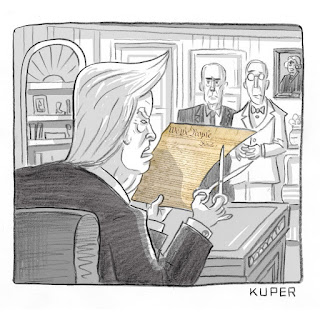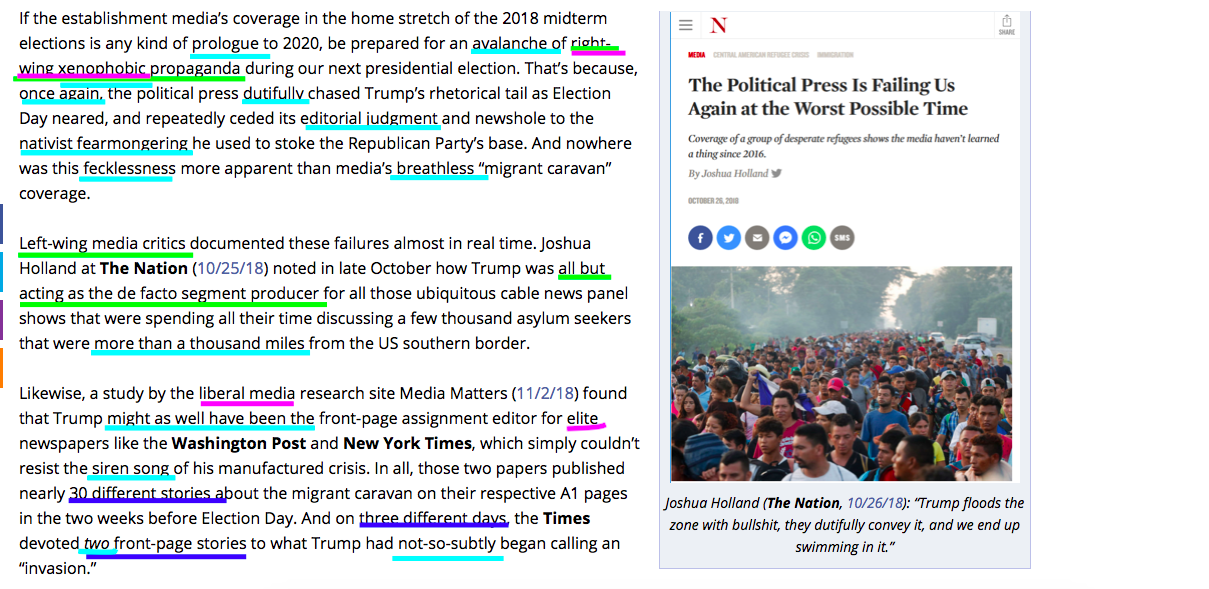New Yorker Political Cartoon
Hey everyone, it's Emily! Today we're unpacking the following political cartoon.
Kuper, Peter. “Daily Cartoon: Thursday, November 1st.” The New Yorker, The New Yorker, 1 Nov. 2018, www.newyorker.com/cartoons/daily-cartoon/thursday-november-1st-obamas-constitution.
(On the New Yorker website, this was accompanied by the caption "Just tell me which part Obama wrote".)
There have been thousands of Trump-themed political cartoons since even before he took office. I chose a recent one so I didn't have to swim through the archives of newspapers with nothing better to produce. In any case, let's get started!
First, let's analyze the style of the cartoonist. The drawings of people are realistic but lack detail and depth, which can contribute to dehumanization of figures. This can be seen especially with the figure we know to be Trump, whose exaggerated toupee, comical high rising eyebrows, and small, pupil-less eyes make him seem more like a demon than human, especially compared to his soft-faced cohorts in the background. The cartoon is mostly black and white, but the Preamble in the middle is in color, drawing the viewer's eye to it immediately. This tells us the artist's opinions (Trump is demonic and inhuman) and goals (draw attention to the Preamble that Trump holds).
Next, let's look at symbolism. The Preamble, likely the first thing a viewer sees, is seen as a symbol of America, and America's important values. Since it was created at the time that America became a free country, it is associated with freedom. The scissors that Trump holds in his ready, small hand symbolize destruction. The cartoonist conveys the message that Trump is a destroyer of freedom. Since scissors are frequently used with crafts, this symbol contributes to the idea of Trump as a childlike, immature figure.
Let's take a look at the caption that the artist included on the New Yorker website. "Just tell me which part Obama wrote". This is a clear use of irony, since Obama definitely did not contribute to the Preamble of the Constitution. It implies that Trump is stupid and knows nothing about American history (and that he probably shouldn't be in office). It also creates two sides, or a rivalry, based on the cartoon: instead of viewer vs. Trump, it's viewer on either Obama or Trump's side.
Overall, this cartoonist casts clear bias to the side of Obama, and gives the impression that Trump is a destructive, anti-American, childish demon with no knowledge of America history but a very sharp pair of scissors and a presidency.
Let me know your thoughts on this cartoon down below. Goodbye for now!

Kuper, Peter. “Daily Cartoon: Thursday, November 1st.” The New Yorker, The New Yorker, 1 Nov. 2018, www.newyorker.com/cartoons/daily-cartoon/thursday-november-1st-obamas-constitution.
(On the New Yorker website, this was accompanied by the caption "Just tell me which part Obama wrote".)
There have been thousands of Trump-themed political cartoons since even before he took office. I chose a recent one so I didn't have to swim through the archives of newspapers with nothing better to produce. In any case, let's get started!
First, let's analyze the style of the cartoonist. The drawings of people are realistic but lack detail and depth, which can contribute to dehumanization of figures. This can be seen especially with the figure we know to be Trump, whose exaggerated toupee, comical high rising eyebrows, and small, pupil-less eyes make him seem more like a demon than human, especially compared to his soft-faced cohorts in the background. The cartoon is mostly black and white, but the Preamble in the middle is in color, drawing the viewer's eye to it immediately. This tells us the artist's opinions (Trump is demonic and inhuman) and goals (draw attention to the Preamble that Trump holds).
Next, let's look at symbolism. The Preamble, likely the first thing a viewer sees, is seen as a symbol of America, and America's important values. Since it was created at the time that America became a free country, it is associated with freedom. The scissors that Trump holds in his ready, small hand symbolize destruction. The cartoonist conveys the message that Trump is a destroyer of freedom. Since scissors are frequently used with crafts, this symbol contributes to the idea of Trump as a childlike, immature figure.
Let's take a look at the caption that the artist included on the New Yorker website. "Just tell me which part Obama wrote". This is a clear use of irony, since Obama definitely did not contribute to the Preamble of the Constitution. It implies that Trump is stupid and knows nothing about American history (and that he probably shouldn't be in office). It also creates two sides, or a rivalry, based on the cartoon: instead of viewer vs. Trump, it's viewer on either Obama or Trump's side.
Overall, this cartoonist casts clear bias to the side of Obama, and gives the impression that Trump is a destructive, anti-American, childish demon with no knowledge of America history but a very sharp pair of scissors and a presidency.
Let me know your thoughts on this cartoon down below. Goodbye for now!


Comments
Post a Comment